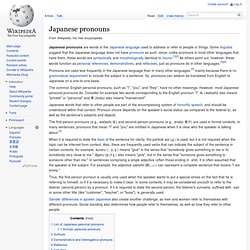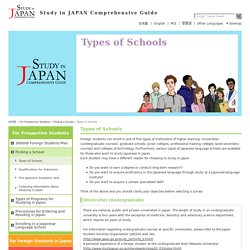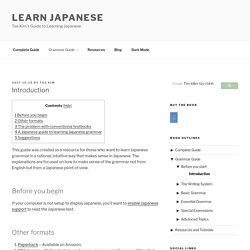

Gaki No Tsukai Police Pt.1. Learn Japanese Language, Kanji Japanese Symbols. The Social J-POP & K-POP Revolution. Ikiru (1952) Ikiru (1952) Akira Kurosawa. Watch Cat Shit One Episode 1 Online English Subbed. Japanese pronouns. Pronouns are used less frequently in the Japanese language than in many other languages,[5] mainly because there is no grammatical requirement to include the subject in a sentence.

So, pronouns can seldom be translated from English to Japanese on a one-to-one basis. The common English personal pronouns, such as "I", "you", and "they", have no other meanings. However, most Japanese personal pronouns do. Consider for example two words corresponding to the English pronoun "I": 私 (watashi) also means "private" or "personal" and 僕 (boku) also means "manservant". Japanese words that refer to other people are part of the encompassing system of honorific speech, and should be understood within that context.
The first-person pronouns (e.g., watashi, 私) and second-person pronouns (e.g., anata, 貴方) are used in formal contexts. Gender differences in spoken Japanese also create another challenge, as men and women refer to themselves with different pronouns. White Rabbit Press. No-Laughing Hot Spring Inn. Shinto. Shinto priest and priestess.

Shinto (神道, Shintō?) , also kami-no-michi,[note 1] is the indigenous religion of Japan and the people of Japan.[2] It is defined as an action-centered religion,[3] focused on ritual practices to be carried out diligently, to establish a connection between present-day Japan and its ancient past.[4] Founded in 660 BC according to Japanese mythology,[5] Shinto practices were first recorded and codified in the written historical records of the Kojiki and Nihon Shoki in the 8th century. Still, these earliest Japanese writings do not refer to a unified "Shinto religion", but rather to a collection of native beliefs and mythology.[6] Shinto today is a term that applies to the religion of public shrines devoted to the worship of a multitude of gods (kami),[7] suited to various purposes such as war memorials and harvest festivals, and applies as well to various sectarian organizations.
Gaki human bowling. Pie hell (2/3) G@ki no T$ukai Ass works 1of2 (Eng. Sub) Radical Index. ThinkMac Software - iKanji. JLPT Kanji Project - Browse by level. Making Sense of Japanese: What the Textbooks Don't Tell You (Power… Renshuu.org - welcome to renshuu.org: Japanese studying made for you! Untitled. 日本搞笑综艺节目 Gaki no Tsukai 絶対に笑ってはいけない高校 未公開シーン. 日本搞笑综艺节目 Downtown Gaki no tsukai 絶対笑ってはいけない警察24時! 日本搞笑综艺节目 笑爆肚子不负责 Gaki No Tsukai - 939 (2009.01.18. No Laughing in Yugawara. No Laughing in Yugawara. 日本搞笑综艺节目 笑爆肚子不负责 Gaki No Tsukai - 絶対に笑ってはいけない病院24時. Matsumoto Hitoshi No Hontou 1/2.
日本搞笑综艺节目 爆笑温泉旅馆之旅2 笑爆肚子不负责 Downtown Gaki no Tsukai Onsen 2 Batsu. DOWNTOWN作品集01(日語中字) Matsumoto Hitoshi DOOHOHOHOHO~ Asian Drama Torrents. Zen Poems, Verses, Quotes, Quips, Koans - #1. . Haiku Poet's Hut: Haiku and Haiku Related Poetry by soji. Stone Bridge Press - Classics. The Japanese Haiku Masters: Links, References, Resources. Oku no Hosomichi by Basho Matso, Kasumi Kobayashi in History. Matsuo Bashō. Types of Schools. Types of Schools Foreign students can enroll in one of five types of institutions of higher learning: Universities (undergraduate courses), graduate schools, junior colleges, professional training colleges (post-secondary courses) and colleges of technology.

Furthermore, various types of Japanese language schools are available for those who want to study Japanese in Japan. Each student may have a different reason for choosing to study in Japan. Do you want to earn a degree or conduct long-term research? Do you want to acquire proficiency in the Japanese language through study at a Japanese-language institute? Think of the above and you should clarify your objective before selecting a school. Universities (Undergraduate) There are national, public and private universities in Japan. For information regarding undergraduate courses at specific universities, please refer to the Japan Student Services Organization (JASSO) web site Graduate schools Junior colleges Special training college. Art of writing japanese kanji and kana - All for your japanese s. Languages - Japanese - A Touch of Japanese - A beginners' Edo_5.jpg (JPEG Image, 2332×1996 pixels) - Scaled (31. 奥の細道 by Bashō Matsuo. Tae Kim's Guide to Learning Japanese.
This guide was created as a resource for those who want to learn Japanese grammar in a rational, intuitive way that makes sense in Japanese.

The explanations are focused on how to make sense of the grammar not from English but from a Japanese point of view. Before you begin If your computer is not setup to display Japanese, you’ll want to enable Japanese support to read the Japanese text. Other formats Paperback – Available on Amazon.PDF Version – Philipp Kerling wrote an awesome script to convert the site to PDF.iOS app – The guide is now available for iOS devices created by Adam Critchley.Android app – The guide is now available on Google Play created by Ignatius Reza Lesmana.
This work is released under a Creative Commons Attribution-Noncommercial-Share Alike License. The problem with conventional textbooks The problem with conventional textbooks is that they often have the following goals. Oku no Hosomichi by Matsuo Bashō. Oku no Hosomichi. 出発まで 月日は百代の過客にして行かふ年も又旅人也。

舟の上に生涯をうかべ、馬の口とらえて老をむかふる物は日々旅にして旅を栖とす。 古人も多く旅に死せるあり。 予もいづれの年よりか片雲の風にさそはれて、漂白の思ひやまず、海濱にさすらへ、去年の秋江上の破屋に蜘の古巣をはらひてやゝ年も暮、春立る霞の空に白川の関こえんと、そゞろ神の物につきて心をくるはせ、道祖神のまねきにあひて、取もの手につかず。 もゝ引の破をつゞり、笠の緒付かえて、三里に灸すゆるより、松嶋の月先心にかゝりて、住る方は人に譲り、杉風が別墅に移るに、 草の戸も住替る代ぞひなの家 面八句を庵の柱に懸置。 旅立 弥生も末の七日、明ぼのゝ空朧々として、月は在明にて光おさまれる物から不二の峯幽にみえて、上野谷中の花の梢又いつかはと心ぼそし。 行春や鳥啼魚の目は泪 是を矢立の初として、行道なをすゝまず。 NKBT reads むつましきかぎりは. 草加. UVa Library Etext Center: Japanese Text Initiative. UVa Library Etext Center: Japanese Text Initiative. Tae Kim's Guide to Learning Japanese. Posted by Tae Kim Declaring something is so and so using 「だ」 Vocabulary 人 【ひと】 - person学生 【がく・せい】 - student元気 【げん・き】 - healthy; lively *Used as a greeting to indicate whether one is well.